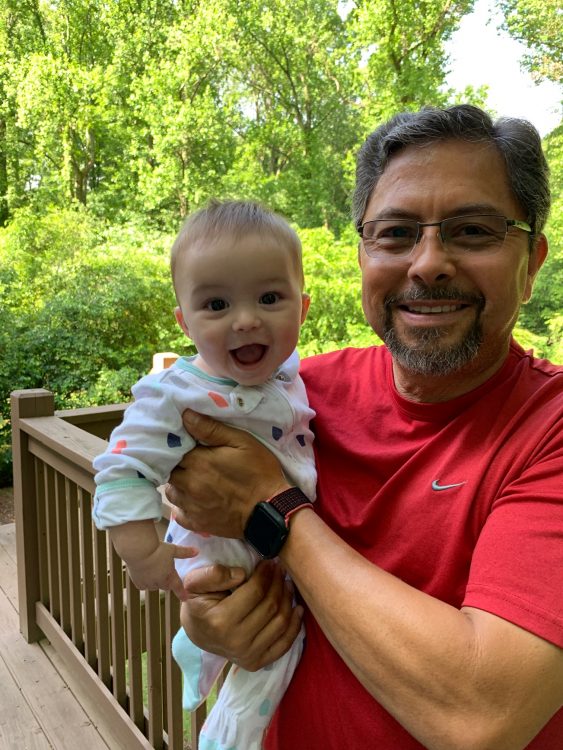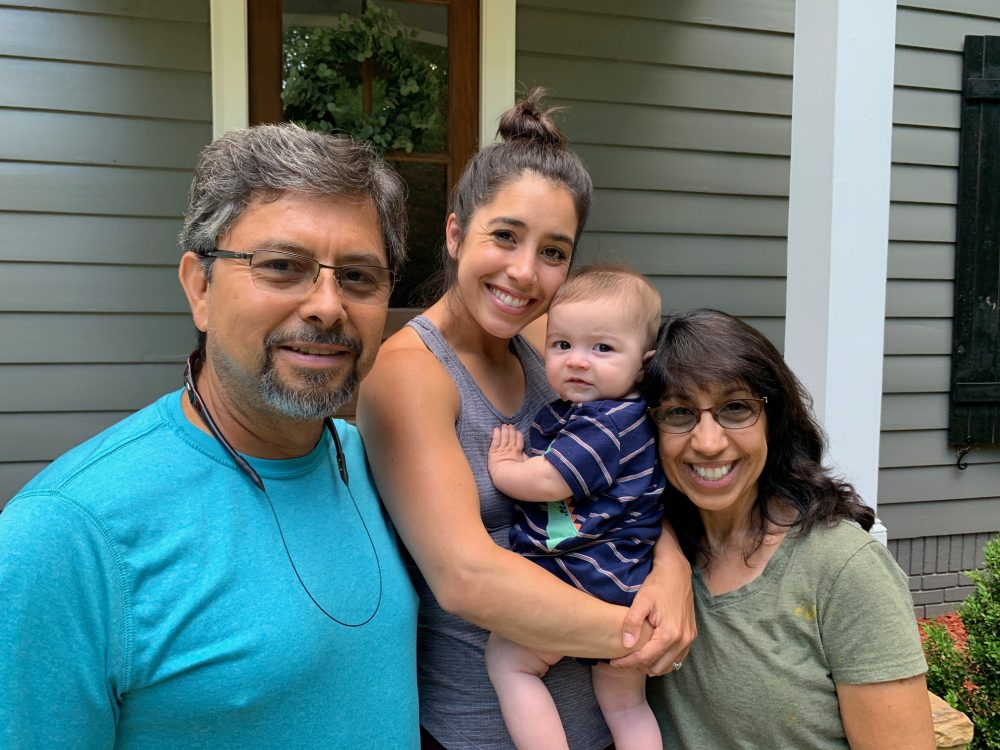
My name is Julio Sanchez, a “Soldier for Life” after proudly serving 28 years in the US Army as a sapper or combat engineer. I live in the Fort Benning (“The Home of the Infantry”) area of Columbus, Georgia. I retired in March 2007. I am married, have two beautiful grown children, and my first grandson was born in November 2019, the same time I was diagnosed with stage IV non-small cell lung cancer (NSCLC). The best and worst time in my life!
The diagnosis was a devastating blow to my life as I knew it! I’m a non-smoker and had never been screened, so it was not even on my radar.
Because I was very physically active throughout my life, running five miles a day and going to the gym three times a week, the persistent sharp pain in the right side of my back that I had for over eight months was misdiagnosed as a strained back muscle or rib cage. After experiencing some excruciating pain, I was finally screened for lung cancer. At that time, half my right lung pleura had filled with fluid, which was extracted with a large needle by a radiologist at Piedmont Hospital.
I can imagine similar reactions to any cancer diagnosis, but I immediately felt like a “dead man walking” when I left my oncologist’s office. Why me? What did I do wrong? How long do I have to live?
I had no clue what was ahead of me, but felt the odds were stacked against me. My doctor had stated I had a 50/50 chance of reacting favorably to the standard protocol treatment recommended for my diagnosis. The treatment consisted of four cycles of carboplatin, Keytruda, and Alimta. I recently received my ninth maintenance chemo treatment, administered every 21 days.

Waiting for the results of the first scheduled PET scan to verify if the prescribed protocol cocktail was working was the most nail-biting event I had in a very long time. It equaled my engagement in combat operations while fighting the war in Iraq and Afghanistan.
Thank God the chemo protocol was working; the results of my first scan were very favorable, indicating about 85% of the cancer had disappeared. It was working for me, and I felt lucky for the first time since being diagnosed. I immediately cried in the doctor’s office and hugged the air out of my wife who was also crying hysterically with me. I hugged the doctor in thanks for his medical care in helping improve my lung cancer diagnosis.
I finally saw a sign of hope in possibly extending my “new life” with these modern wonder drugs. I know that research has helped others like me manage this dreaded disease, so I support increased research funding. Lung cancer, after all, has the highest death rate of all cancers, with an estimated 135,700 deaths in 2020.
I feel so blessed and lucky TODAY to have access to medical treatment for lung cancer. It is helping me live longer and spend more time with my loved ones and friends! When I finally saw hope on my horizon, I decided to reach out to my local cancer center and the Veterans Administration (VA) to find organizations and support groups that could help me manage my diagnosis. Unfortunately, there are currently no lung cancer support groups within 100 miles of my area.
I started hammering the internet, desperately searching for assistance. I was becoming a mental case without help specific to my diagnosis. One of the organizations I found comfort in talking to was GO2 for Lung Cancer, who provided me with a lot of great information. They then followed-up on my condition and answered all my questions.
Access Health’s “Living with Non-small Cell Lung Cancer” special, featuring Julio.
GO2 for Lung Cancer also linked me up with a “battle buddy” [Phone Buddy] who is fighting the same enemy, but with two years of experience ahead of me. That personal connection helped me immensely because he was already in the same foxhole engaging the lung cancer opponent I was facing!

Veterans have a higher incident rate than the regular population because of their environmental and hazardous exposures during tours of duty. Unless you’re a longtime smoker and over a specific age, there is no recommended early testing. There are more than 7,000 vets diagnosed annually with lung cancer and most are in the late stages of the disease when they finally demonstrate symptoms.
We need increased awareness about lung cancer screening options and improved outcomes for all Veterans impacted by lung cancer.
I am sharing my lung cancer experience to “pay it forward” by providing support, advice, lessons learned, and resources to fight our lung cancer battle. I strongly believe early screening protocols by the VA will save thousands of lives each year.
I personally thank everyone involved in lung cancer research, prevention, and treatment who are devoted to improving screening and treatments protocols to help American Vets, like me, live longer! More research and more screening will support military mission readiness and protect our men and women who serve and the millions who are impacted by lung cancer.
Find out more about Veterans and lung cancer on our Veterans-specific webpages, where you can also read about our new partnership with the VA.

So happy for your success I am an 18 year survivor of stage IV lung cancer and I agree that more screening is necessary.
Great to hear you’re still in the Battle and Winning!
Hello Caryn,
We may never meet but please know my feelings are mixed with both happiness for you and sadness for my wife, Kimberly, who passed at just 4 years with stage IV. When I come across other patients with longer survival rates – its very difficult for myself. Life is not fair. I know one’s DX is different from another, yet it still hits hard. I only wish you the best and please do as you want in life, don’t let anyone get in your way, even family. They may never understand, as you and I know all too well – “time” is a double edge sword. God Bless. R/ Joseph Letizia. ( my story is posted under “veterans spotlight”. )
[…] Sanchez called his Phone Buddy his “battle buddy” when he was featured on GO2 for Lung Cancer’s Veteran Spotlight blog and Lung Cancer Living Room video series.. “That personal connection helped me immensely,” […]